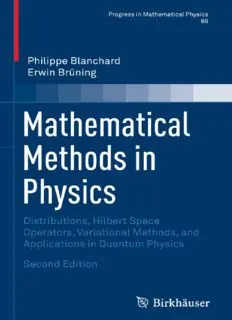Table Of ContentProgress in Mathematical Physics
Volume 69
Editors-in-chief
AnneBoutetdeMonvel,UniversitéParisVIIUFRdeMathematiques,
ParisCX05,France
GeraldKaiser,CenterforSignalsandWaves,Portland,Oregon,USA
EditorialBoard
C.Berenstein,UniversityofMaryland,CollegePark,USA
SirM.Berry,UniversityofBristol,UK
P.Blanchard,UniversityofBielefeld,Germany
M.Eastwood,UniversityofAdelaide,Australia
A.S.Fokas,UniversityofCambridge,UK
F.W.Hehl,UniversityofCologne,Germany
andUniversityofMissouri-Columbia,USA
D.Sternheimer,UniversitédeBourgogne,Dijon,France
C.Tracy,UniversityofCalifornia,Davis,USA
Forfurthervolumes:
http://www.springer.com/series/4813
Philippe Blanchard (cid:129) Erwin Brüning
Mathematical Methods
in Physics
Distributions, Hilbert Space Operators,
Variational Methods, and Applications
in Quantum Physics
Second Edition
PhilippeBlanchard ErwinBrüning
Abt.TheoretischePhysik SchoolofMathematics,Statistics,
UniversitätBielefeldFak.Physik andComputerScience
Bielefeld UniversityofKwaZulu-Natal
Germany Durban
SouthAfrica
ISSN1544-9998 ISSN2197-1846(electronic)
ProgressinMathematicalPhysics
ISBN978-3-319-14044-5 ISBN978-3-319-14045-2(eBook)
DOI10.1007/978-3-319-14045-2
LibraryofCongressControlNumber:2015931210
MathematicsSubjectClassification(MSC):46-01,46C05,46F05,46N50,47A05,47L90,49-01,60E05,
81Q10
SpringerChamHeidelbergNewYorkDordrechtLondon
© SpringerInternationalPublishingSwitzerland2003,2015
Thisworkissubjecttocopyright.AllrightsarereservedbythePublisher,whetherthewholeorpartofthe
materialisconcerned,specificallytherightsoftranslation,reprinting,reuseofillustrations,recitation,
broadcasting,reproductiononmicrofilmsorinanyotherphysicalway,andtransmissionorinformation
storageandretrieval,electronicadaptation,computersoftware,orbysimilarordissimilarmethodology
nowknownorhereafterdeveloped.
Theuseofgeneraldescriptivenames,registerednames,trademarks,servicemarks,etc.inthispublication
doesnotimply,evenintheabsenceofaspecificstatement,thatsuchnamesareexemptfromtherelevant
protectivelawsandregulationsandthereforefreeforgeneraluse.
Thepublisher,theauthorsandtheeditorsaresafetoassumethattheadviceandinformationinthisbook
arebelievedtobetrueandaccurateatthedateofpublication.Neitherthepublishernortheauthorsorthe
editorsgiveawarranty,expressorimplied,withrespecttothematerialcontainedhereinorforanyerrors
oromissionsthatmayhavebeenmade.
Printedonacid-freepaper
SpringerispartofSpringerScience+BusinessMedia(www.springer.com)
Dedicatedtothememoryof
YurkoVladimirGlaserandResJost,
mentorsandfriends
Preface to the Second Edition
The first edition of this book was published in 2003. Let us first thank everyone
who, over the past 11 years, has provided us with suggestions and corrections for
improvingthisfirstedition.Weareextremelygratefulforthishelp.
Thepastdecadehasbroughtmanychanges,buttheaimofthisbookremainsthe
same.Itisintendedforgraduatestudentsinphysicsandmathematicsanditmayalso
beusefulfortheoreticalphysicistsinresearchandinindustry.Astheextendedtitle
ofthissecondeditionindicates, wehavefocusedourattentiontoalargeextenton
topicalapplicationstoQuantumPhysics.
Withthehopethatthisbookwouldbeausefulreferenceforpeopleapplyingmath-
ematicsintheirwork,wehaveemphasizedtheresultsthatareimportantforvarious
applications in the areas indicated above. This book is essentially self-contained.
Perhapssomereaderswillusethisbookasacompendiumofresults;thiswouldbea
pity,however,becauseproofsareoftenasimportantasresults.Mathematicalphysics
isnotapassiveactivity,andthereforethebookcontainsmorethan220exercisesto
challengereadersandtofacilitatetheirunderstanding.
This second edition differs from the first through the reorganization of certain
materialandtheadditionoffivenewchapterswhichhaveanewrangeofsubstantial
applications.
ThefirstadditionisChap.13“Sobolevspaces”whichoffersabriefintroduction
tothebasictheoryofthesespacesandthuspreparestheiruseinthestudyoflinear
andnonlinearpartialdifferentialoperatorsand,inparticular,inthethirdpartofthis
bookdedicatedto“VariationalMethods.”
While in the first edition Hilbert–Schmidt and trace class operators were only
discussed briefly in Chap. 22 “Special classes of bounded operators,” this edition
containsanewChap.26“Hilbert–Schmidtandtraceclassoperators.”Theremainder
ofChap.22hasbeenmergedwiththeold,shorterChap.23“Self-adjointHamilton
operators”toformthenewChap.23“Specialclassesoflinearoperators,”whichnow
alsocontainsabriefsectiononvonNeumann’sbeautifulapplicationofthespectral
theoryforunitaryoperatorsinergodictheory.
Chapter 26 “Hilbert–Schmidt and trace class operators” gives a fairly compre-
hensiveintroductiontothetheoryoftheseoperators. Furthermore, thedualspaces
ofthespacesofcompactandoftraceclassoperatorsaredetermined,whichallows
vii
viii PrefacetotheSecondEdition
athoroughdiscussionofseverallocallyconvextopologiesonthespaceB(H)ofall
bounded linear operators on a separable Hilbert space H. These are used later in
thechapter“Operatoralgebrasandpositivemappings”tocharacterizenormalstates
on von Neumann algebras. This chapter also contains the definition of the partial
traceoftraceclassoperatorsonthetensorproductsoftwoseparableinfinitedimen-
sionalHilbertspacesandstudiesitsmainproperties.Theseresultsareofparticular
importanceinthetheoryofopenquantumsystemsandthetheoryofdecoherence.
ThemotivationforthenewChap.29“SpectralanalysisinriggedHilbertspaces”
comesfromthefactthat,ononeside,Dirac’sbraandketformalismiswidelyand
successfullyemployedintheoreticalphysics,butitsmathematicalfoundationisnot
easilyaccessible.Thischapteroffersanearlyself-containedmathematicalbasisfor
thisformalismandprovesinparticularthecompleteness?thereisawordmissingin
thissentencecompletenessofthesetofgeneralizedeigenfunctions.
InChap.30“Operatoralgebrasandpositivemappings,”westudyindetailpos-
itive and completely positive mappings on the algebra B(H) of all bounded linear
operatorsonaHilbertspaceHrespectivelyonitssubalgebras.WeexplaintheGNS
construction for positive linear functionals in detail and characterize states, i.e.,
normalizedpositivelinearfunctionals,intermsoftheirequivalentcontinuityproper-
ties(normal,completelyadditive,tracial).Next,Stinespring’sfactorizationtheorem
characterizescompletelypositivemapsintermsofrepresentations.Sinceallrepre-
sentationsofB(H)aredeterminedtoo,wecangiveaself-containedcharacterization
ofallcompletelypositivemappingsonB(H).
Thelastnewchapter,Chap.31“Positivemappingsinquantumphysics,”presents
severalresultswhichareveryimportantforthefoundationsofquantumphysicsand
quantum information theory. We start with a detailed discussion of Gleason’s the-
orem on the general form of countable additive probability measures on the set of
projectionsofaseparableHilbertspace. Usingsomeoftheresultsoftheprevious
chapter,wethengiveaself-containedcharacterizationofquantumoperationsspecif-
ically,quantumchannelmaps(Krausform)andconcludewithabriefdiscussionof
thestrongerformoftheseresultsiftheunderlyingHilbertspaceisfinitedimensional
(Choi’scharacterizationofquantumoperations).
Onthebasisofthemathematicalresultsobtainedinthisandearlierchapters, it
isstraightforwardtointroducesomequiteprominentconceptsinquantumphysics,
namelyopenquantumsystems,reduceddynamics,anddecoherence.Thisisdonein
thelastsectionofthischapter.
BielefeldandDurban Ph.Blanchard
May2014 E.Brüning
Preface
Courses in modern theoretical physics have to assume some basic knowledge of
the theory of generalized functions (in particular distributions) and of the theory
of linear operators in Hilbert spaces. Accordingly, the faculty of physics of the
UniversityofBielefeldofferedacompulsorycourseMathematischeMethodender
Physikforstudentsinthesecondsemesterofthesecondyear,whichnowhasbeen
given for many years. This course has been offered by the authors over a period
of about 10 years. The main goal of this course is to provide basic mathematical
knowledgeandskillsastheyareneededformoderncoursesinquantummechanics,
relativistic quantum field theory, and related areas. The regular repetitions of the
course allowed, on the one hand, testing of a number of variations of the material
and, on the other hand, the form of the presentation. From this course, the book
Distributionen und Hilbertraumoperatoren. Mathematische Methoden der Physik.
Springer-VerlagWien,1993emerged.Thepresentbookisatranslated,considerably
revised,andextendedversionofthisbook.Itcontainsmuchmorethanthiscourse
sinceweaddedmanydetailedproofs,manyexamples,andexercisesaswellashints
linking the mathematical concepts or results to the relevant physical concepts or
theories.
This book addresses students of physics who are interested in a conceptually
and mathematically clear and precise understanding of physical problems, and it
addressesstudentsofmathematicswhowanttolearnaboutphysicsasasourceand
asanareaofapplicationofmathematicaltheories,i.e.,allthosestudentswithinterest
inthefascinatinginteractionbetweenphysicsandmathematics.
Itisassumedthatthereaderhasasolidbackgroundinanalysisandlinearalgebra
(inBielefeldthismeansthreesemestersofanalysisandtwooflinearalgebra). On
this basis the book starts in PartA with an introduction to basic linear functional
analysisasneededfortheSchwartztheoryofdistributionsandcontinuesinPartB
withtheparticularitiesofHilbertspacesandthecoreaspectsofthetheoryoflinear
operatorsinHilbertspaces.PartCdevelopsthebasicmathematicalfoundationsfor
modern computations of the ground state energies and charge densities in atoms
andmolecules,i.e.,basicaspectsofthedirectmethodsofthecalculusofvariations
includingconstrainedminimization.Apowerfulstrategyforsolvinglinearandnon-
linearboundaryandeigenvalueproblems, whichcoverstheDirichletproblemand
ix
x Preface
itsnonlineargeneralizations,ispresentedaswell.Anappendixgivesdetailedproofs
ofthefundamentalprinciplesandresultsoffunctionalanalysistotheextenttheyare
neededinourcontext.
Withgreatpleasurewewouldliketothankallthosecolleaguesandfriendswho
have contributed to this book through their advice and comments, in particular G.
Bolz, J. Loviscach, G. Roepstorff, and J. Stubbe. Last but not least we thank the
editorialteamofBirkhäuser—Bostonfortheirprofessionalwork.
BielefeldandDurban Ph.Blanchard
June2002 E.Brüning

